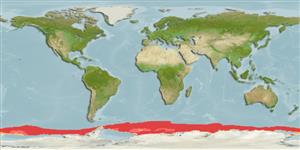>
Aulopiformes (Grinners) >
Anotopteridae (Daggertooth)
Etymology: Anotopterus: Greek, a = without + Greek, noton = back + Greek, pteron = fin (Ref. 45335).
More on author: Regan.
Environment: milieu / climate zone / distribuzione batimetrica / distribution range
Ecologia
marino batipelagico; distribuzione batimetrica 0 - 2579 m (Ref. 36355). Deep-water; 55°S - 72°S
Southern Ocean: circumglobal (Ref. 31260). Collected from Meteor and Maud rises, in the Lazarev Sea, and near the South Sandwich Islands (Ref. 36355).
Size / Peso / Age
Maturità: Lm ? range ? - ? cm
Max length : 105 cm SL maschio/sesso non determinato; (Ref. 31260); common length : 90.0 cm NG maschio/sesso non determinato; (Ref. 5755)
Short description
Chiavi di identificazione | Morfologia | Morfometria
Spine dorsali (totale) : 0; Raggi dorsali molli (totale) : 0; Raggi anali molli: 13 - 16; Vertebre: 81 - 85. In adults, head depth 21.3-23.2% of lower jaw length; postorbital region 5.0-6.7% SL or 25.5-30% HL (1/3 of HL). Rear edge of gill cover overlaps with the vertical of the middle of the 4th vertebrae. Pectoral fins begin at the vertical of the end of the 4th to beginning of 5th vertebrae. Postadipose distance represents 4.6-5.9% SL (Ref. 31260).
Body shape (shape guide): elongated; Cross section: compressed.
Inhabits the epimesopelagic layer of the southern ocean circumglobally. Only fry and juveniles were observed in subtropical waters; large adults encountered in sub-Antarctic and Antarctic waters. Capable of shedding teeth and reducing gastrointestinal tract prior to spawning. Monocyclic, that is, they die after the first spawning (a reproductive strategy that evolved as a result of the large distance between feeding and spawning areas). Main food is
Notolepis coatsi which are 15-38 cm in length and weighs to 57-90 g (Ref. 31260).
Life cycle and mating behavior
Maturità | Riproduzione | Deposizione | Uova | Fecundity | Larve
Kukuev, E.I., 1998. Systematics and distribution in the world ocean of daggertooth fishes of the genus Anotopterus (Anotopteridae, Aulopiformes). J. Ichthyol. 38(9):716-729. (Ref. 31260)
IUCN Red List Status (Ref. 130435: Version 2025-1)
Threat to humans
Harmless
Human uses
Strumenti
Special reports
Download XML
Fonti Internet
Estimates based on models
Preferred temperature (Fonte Biblio.
123201): -0.5 - 1.5, mean 0.7 °C (based on 292 cells).
Phylogenetic diversity index (Fonte Biblio.
82804): PD
50 = 0.7500 [Uniqueness, from 0.5 = low to 2.0 = high].
Bayesian length-weight: a=0.00389 (0.00180 - 0.00842), b=3.12 (2.94 - 3.30), in cm total length, based on all LWR estimates for this body shape (Ref.
93245).
Trophic level (Fonte Biblio.
69278): 4.5 ±0.80 se; based on food items.
Resilienza (Fonte Biblio.
120179): Basso, tempo minimo di raddoppiamento della popolazione 4.5 - 14 anni (Assuming tmax>10).
Fishing Vulnerability (Ref.
59153): Very high vulnerability (77 of 100).
🛈
